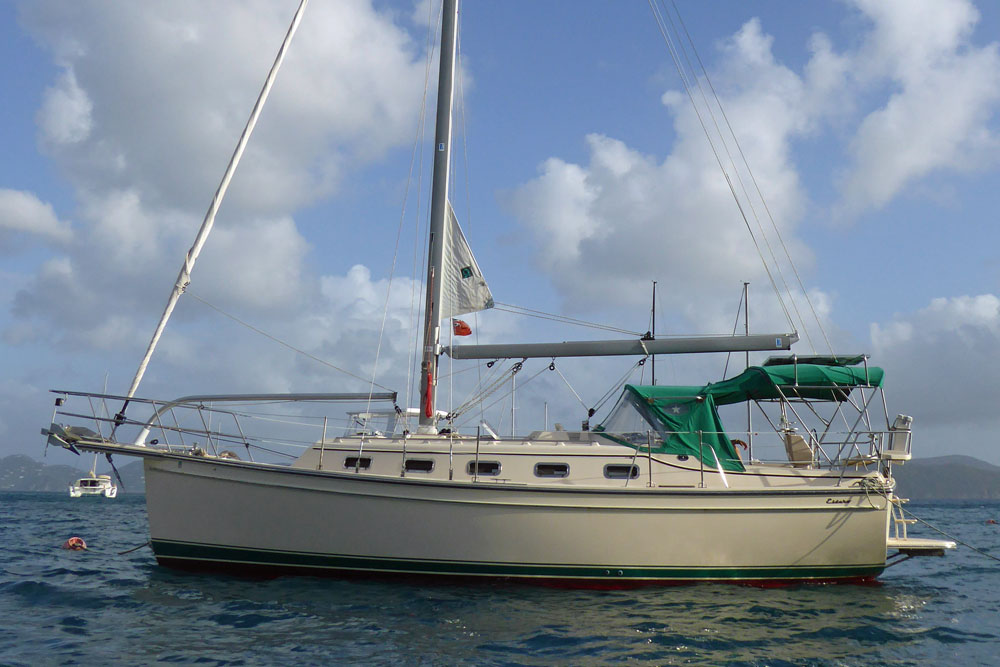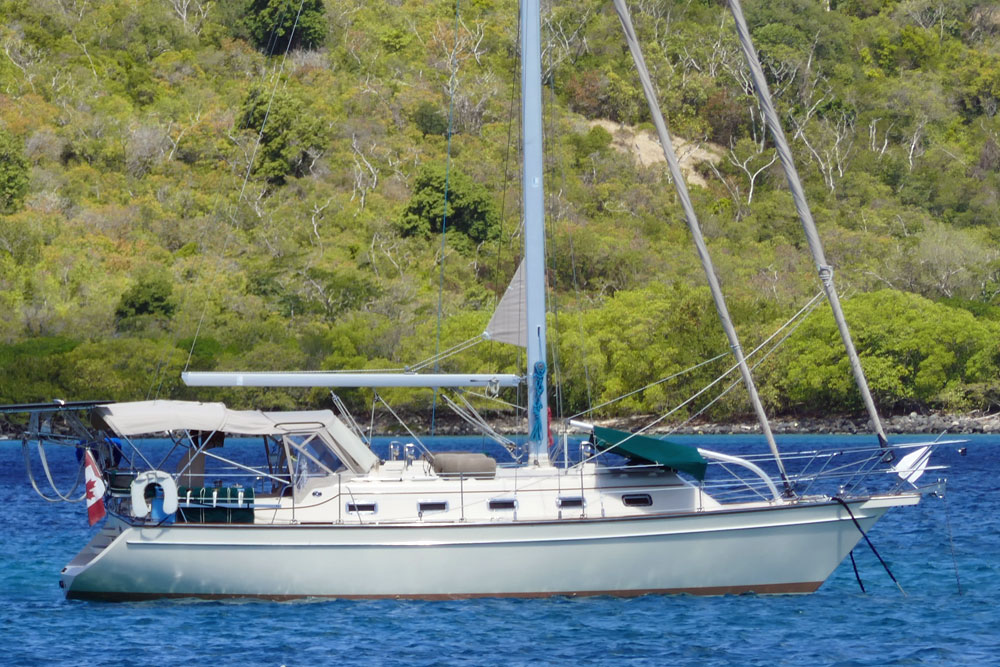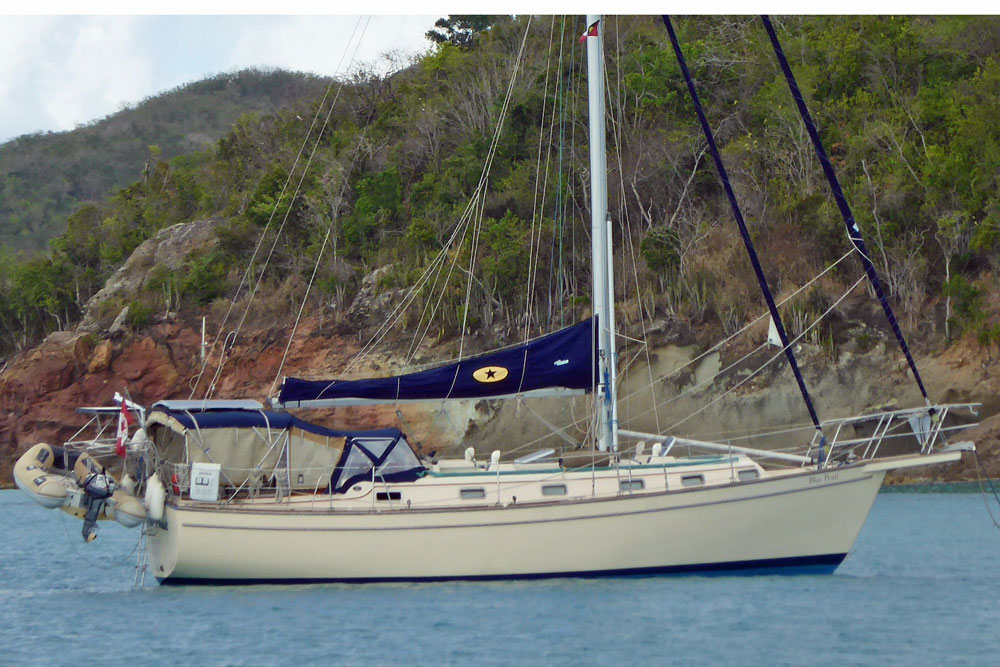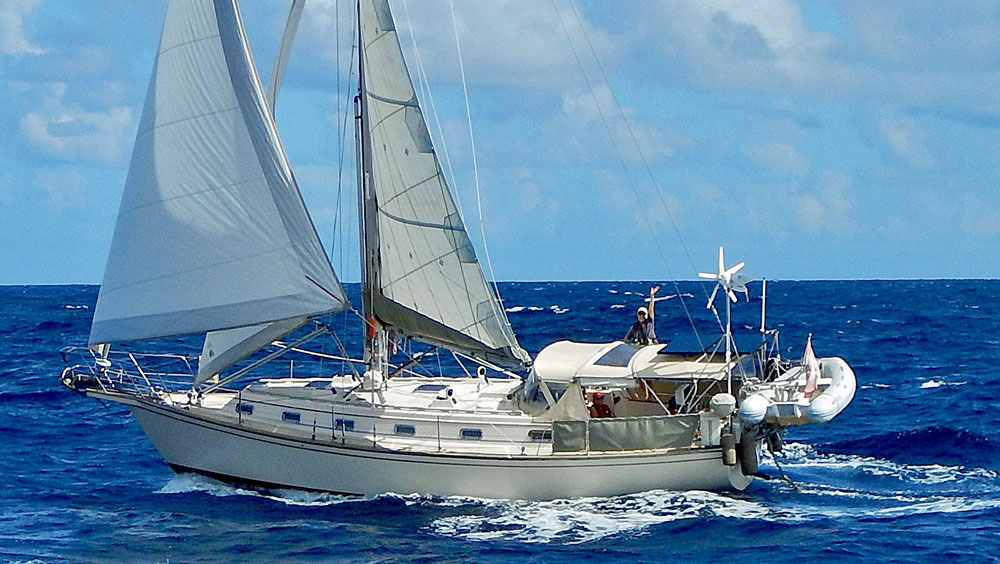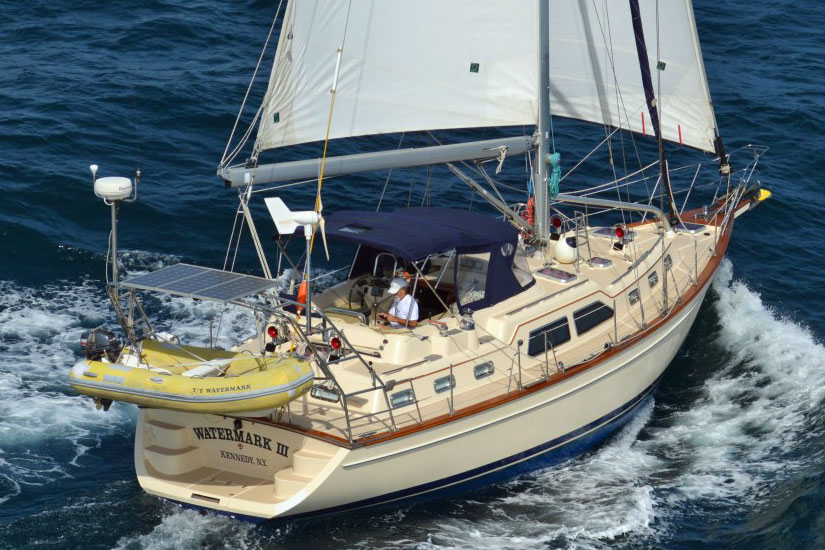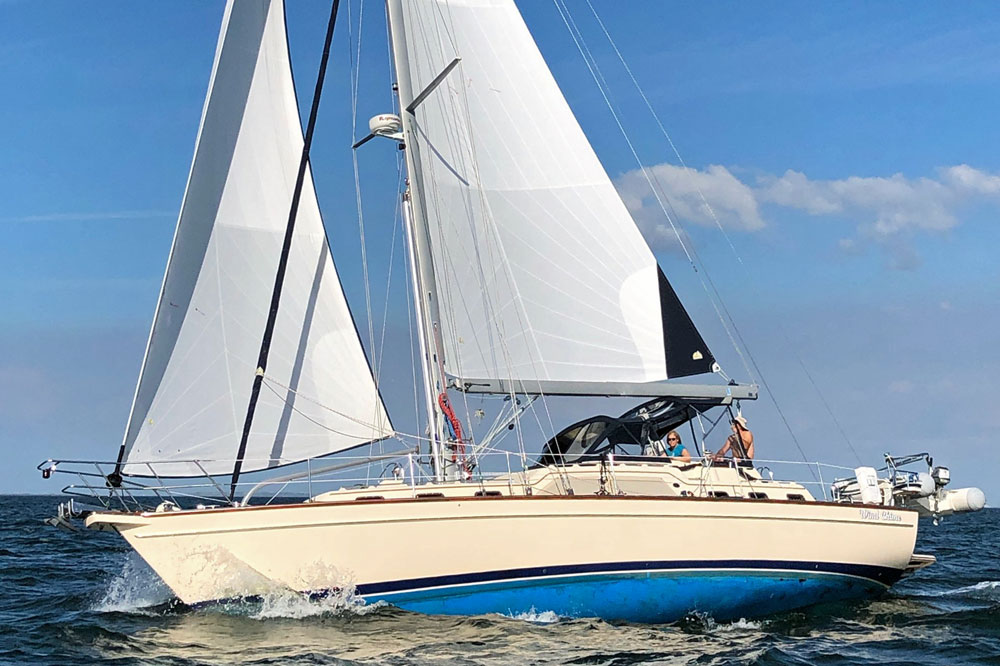- Home
- Cruising Yachts 35' to 40'
- Island Packet 380
The Island Packet 380 Sailboat
The Island Packet 380, a long-keeled cutter, was designed by Bob Johnson and built in the USA by Island Packet Yachts.
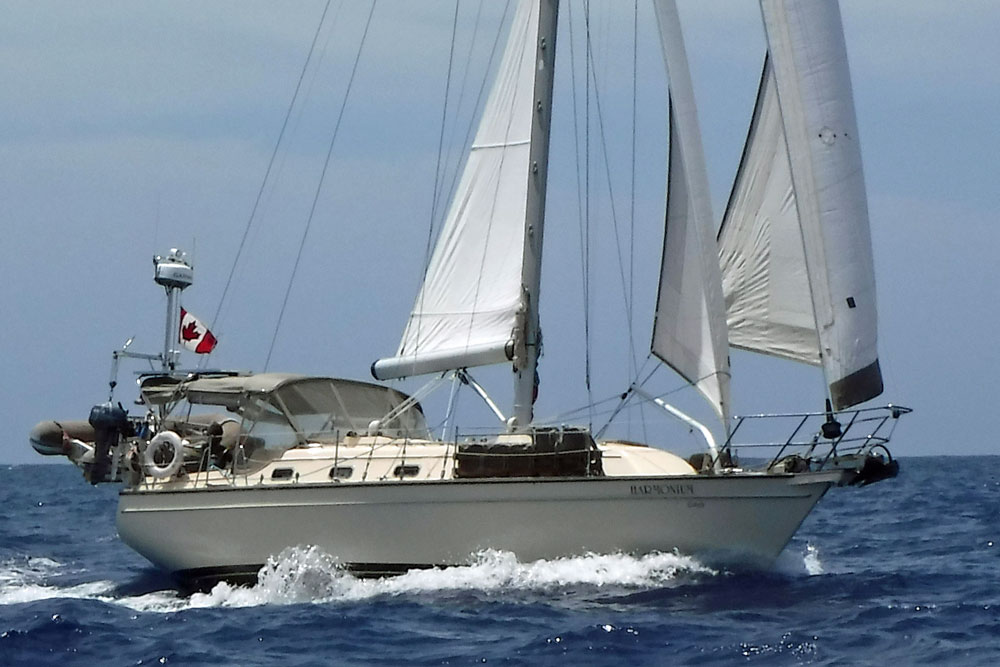 Note the in-boom roller furling mainsail and the Hoyt staysail boom on this Island Packet 380 cutter.
Note the in-boom roller furling mainsail and the Hoyt staysail boom on this Island Packet 380 cutter.Published Specification for the Island Packet 380
Underwater Profile: Long keel
Hull Material: GRP (Fiberglass)
Length Overall: 39'7" (12.00m)
Waterline Length: 32'0" (9.8m)
Beam: 13'0" (4.0m)
Draft: 4'4" (1.3m)*
Rig Type: Cutter
Displacement: 21,000lb (9,526kg)
Designer: Bob Johnson
Builder: Island Packet Yachts (USA)
Year First Built: 1999
Year Last Built: 2004
Owners Association: Island Packet Yacht Owners Association
* A centreboard version is also available - 3'11" draught with the board up, 7'7" with it down.
Published Design Ratios for the Island Packet 380
1. Sail Area/Displacement Ratio: 15.5
2. Ballast/Displacement Ratio: 40.0
3. Displacement/Length Ratio: 307
4. Comfort Ratio: 30.6
5. Capsize Screening Formula: 1.8
Performance Predictions, Based on the Design Ratios
The design ratios that can give us an idea of how the boat performs under sail. These ratios are not definitive, but they can help us compare different boats and make some general predictions.
- Sail Area to Displacement Ratio (SA/D): This ratio measures how much sail power the boat has relative to its weight. A higher ratio means a faster and more responsive boat, while a lower ratio means a slower and more stable boat. The SA/D for the Island Packet 380 is 15.5, which is on the low end of the spectrum for cruising boats. This means that the boat is not very fast or agile, but it is very stable and comfortable in heavy seas.
- Displacement to Length Ratio (D/L): This ratio measures how heavy the boat is relative to its waterline length. A higher ratio means a heavier and more seaworthy boat, while a lower ratio means a lighter and more performance-oriented boat. The D/L for the Island Packet 380 is 307, which is on the high end of the spectrum for cruising boats. This means that the boat is very solid and robust, but it also has more wetted surface and drag, which reduces its speed potential.
- Ballast to Displacement Ratio (B/D): This ratio measures how much weight is in the keel relative to the total weight of the boat. A higher ratio means a stiffer and more stable boat, while a lower ratio means a more tender and lively boat. The B/D for the Island Packet 380 is 40%, which is on the high end of the spectrum for cruising boats. This means that the boat has a lot of righting moment and can carry more sail in stronger winds, but it also has more inertia and resistance to turning.
- Capsize Screening Formula (CSF): This formula measures how prone the boat is to capsize in extreme conditions. A lower value means a safer and more seaworthy boat, while a higher value means a more risky and less seaworthy boat. The CSF for the Island Packet 380 is 1.83, which is below the threshold of 2 that is considered safe for offshore cruising. This means that the boat has a low probability of capsizing in severe weather.
Production Period and Numbers Produced
The Island Packet 380 was introduced in 1999 as a replacement for the Island Packet 37, which was discontinued in 1998. The Island Packet 380 was produced until 2004, when it was replaced by the Island Packet 370, which had some minor changes in layout and rigging. During its production run, 169 units of the Island Packet 380 were built.
Alternative Versions & Options
The Island Packet 380 was offered with two different interior layouts: standard and optional. The standard layout had two cabins and one head, while the optional layout had one cabin and two heads. Both layouts had a spacious saloon with a U-shaped settee to port and an L-shaped settee to starboard, which could be converted into berths if needed.
The standard layout had a large aft cabin with an athwartships double berth and ample storage space, while the optional layout had a smaller aft cabin with an offset double berth and an ensuite head with shower. The forward cabin was identical in both layouts, with a V-berth that could be extended into an island double berth by inserting a filler cushion.
The galley was located to starboard near the companionway in both layouts, with plenty of counter space, storage, and appliances. The galley had a three-burner stove with oven, a double sink, a top-loading refrigerator, and a separate freezer. The navigation station was located to port opposite the galley, with a large chart table, an instrument panel, and a swivel seat.
The Island Packet 380 was equipped with a cutter rig, which consisted of a mainsail, a 110% genoa, and a self-tacking staysail. The mainsail had a full-batten design with two reef points and a stack pack system for easy handling. The genoa and the staysail had roller furling systems for convenience and versatility.
The Island Packet 380 had a Yanmar 4JH3E diesel engine that delivered 56 horsepower and drove a three-bladed propeller through a reduction gear. The engine was located under the cockpit sole and was accessible from all sides through removable panels. The fuel tank had a capacity of 85 gallons (322 liters), which gave the boat a cruising range of about 500 nautical miles at 6 knots. The water tank had a capacity of 170 gallons (644 liters), which provided enough fresh water for long passages. The boat also had two holding tanks, one for each head, with a total capacity of 40 gallons (151 liters).
The Island Packet 380 had a spacious cockpit with high coamings and comfortable seats. The cockpit had a folding table that could be used for dining or charting. The helm station was located aft, with a large wheel, an instrument pod, and an engine control panel. The cockpit also had two large lockers for storage and access to the steering system and the emergency tiller. The boat had a sugar scoop transom with a fold-down swim ladder and cockpit shower.
The Island Packet 380 had a wide side deck with high lifelines and handrails for safety. The bow platform had two anchor rollers and an electric windlass for easy anchoring. The boat also had davits at the stern for carrying a dinghy.
Number & Location of Sleeping Berths
The Island Packet 380 had six sleeping berths in total: two in the forward cabin, two in the aft cabin, and two in the saloon. The forward cabin had a V-berth that could be extended into an island double berth by inserting a filler cushion. The aft cabin had either an athwartships double berth (standard layout) or an offset double berth (optional layout). The saloon had a U-shaped settee to port and an L-shaped settee to starboard, which could be converted into berths if needed.
History of the Boatbuilder
Island Packet Yachts is an American boatbuilder that was founded in 1979 by Bob Johnson, who is also the chief designer of the company. Johnson started his career as an aerospace engineer, but he soon realized his passion for sailing and boat design. He designed and built his first boat, the Island Packet 26, in his garage in Florida. The boat was well-received by the sailing community and Johnson decided to start his own company to produce more boats.
Island Packet Yachts is known for its distinctive style of cruising boats, which feature ivory-colored hulls, rounded coachroofs, full-foil keels, cutter rigs, and spacious interiors. The company has won many awards and accolades for its quality and innovation, such as the Cruising World Boat of the Year Award, the Sail Magazine Best Boats Award, and the NMMA Innovation Award.
Island Packet Yachts has produced over 40 models of sailboats ranging from 26 to 52 feet in length. Some of the most popular models include the Island Packet 31, the Island Packet 35, the Island Packet 38, the Island Packet 420, and the Island Packet 485. The company also produces powerboats under the name Blue Jacket Yachts.
Island Packet Yachts is based in Largo, Florida, where it has a state-of-the-art facility that covers over 12 acres of land. The company employs over 100 skilled craftsmen who use traditional methods and modern technology to build each boat with care and attention to detail.
Secondhand Values
The Island Packet 380 is no longer in production, but it is still in high demand on the secondhand market. According to YachtWorld, the average asking price for an Island Packet 380 is $191,725 USD as of April 2023. The lowest asking price is $184,000 USD for a 1999 model in Florida, while the highest asking price is $219,900 USD for a 2004 model in Maryland.
The above text was drafted by sailboat-cruising.com using GPT-4 (OpenAI’s large-scale language-generation model) as a research assistant to develop source material; we believe it to be accurate to the best of our knowledge.
Other sailboats in the Island Packet range include:
Recent Articles
-
Ohlson 38 Guide: Specs, Performance Analysis & Cruising Review
Jan 07, 26 05:52 AM
Discover the Ohlson 38 sailboat. An in-depth look at its Einar Ohlson design, Tyler GRP construction, performance ratios, and why it remains a top choice for offshore sailors. -
Passoa 47 Sailboat Review: Comprehensive Specs & Performance Analysis
Jan 04, 26 04:57 AM
Discover the Passoa 47, a legendary aluminium blue water cruiser by Garcia. Explore technical specifications, design ratios, and why its lifting keel is a game-changer for offshore sailors. -
Sailboat Wheel Steering Maintenance & Inspection Checklist
Dec 30, 25 02:32 PM
Keep your vessel’s helm responsive and reliable with our expert maintenance checklist. Master cable tensioning and system inspections to avoid mid-passage failures.
